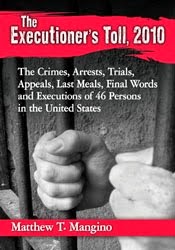Matthew T. Mangino
The Vindicator
December 13, 2015
The evolution of the death penalty in Ohio is
nothing less than astonishing. Five years ago, Ohio was second only to Texas
with 10 executions in a single year. This year, Ohio did not carry out a single
execution. The state has not executed an inmate since Jan. 16, 2014 when Dennis
McGuire struggled and gasped for several minutes before succumbing to a
combination of drugs being used for the first time in the United States.
Executions are not the only thing plummeting in
Ohio. The number of capital murder indictments filed across the state since
2010 has dropped by 77 percent – just 19 capital indictments have been brought
this year, reported the Cleveland Plain Dealer.
However, that is not entirely surprising. In
Cuyahoga County, which has the second most capital convictions in the state,
there is a change in philosophy.
In 2013, Cuyahoga County elected a new prosecutor.
Tim McGinty is not only less likely to seek the death penalty but has written
to the parole board on behalf of a condemned inmate declaring that under his
leadership the office changed its approach to capital punishment.
McGinty alluded to the fact that a life sentence
without the possibility of parole is now a sentencing option, though it was not
25 years ago when the inmate was convicted.
Since 2010, the number of inmates sentenced to life
without parole has spiked 92 percent, according to the Plain Dealer. The Death
Penalty Information Center’s statistics show that the number of inmates
sentenced to death nationally has dropped 35 percent since 2010, when there
were 114 death sentences. Last year, there were 73.
National trend
The Ohio numbers mirror a national trend involving
the death penalty. Even though an October Gallup Poll showed that 61 percent of
the public still supports the death penalty, executions are at a 25-year low.
America’s last execution occurred Tuesday night in
Georgia. It was the 28th execution this year, nearly half the number carried out
in 2009. The number of executions this year is almost the same as the number of
fatalities from lightning strikes – 26 deaths by lightning.
It is an ironic statistic, as pointed out by
National Public Radio, when the Supreme Court briefly banned the death penalty
in 1972. Justice Potter Stewart, a former Ohioan, wrote “These death sentences
are cruel and unusual in the same way that being struck by lightning is cruel
and unusual.”
The death penalty returned in 1976, and by the 1990s
the number of executions soared – hitting a high of 98 in 1999 and ultimately
totaling more than 1,400 – but executions tailed off dramatically after 2000.
The death penalty has been under siege. A number of
states – Connecticut, Illinois, Maryland, New Jersey, New Mexico, New York and
Nebraska – have recently abandoned capital punishment. The governors of four
other states – Colorado, Oregon, Pennsylvania and Washington – have imposed
execution moratoriums.
New Hampshire abolished the death penalty this year
only to have the state’s governor rally to have the matter placed on the ballot
for voter consideration next year. If that is not strange enough, as lethal
injection drugs become more and more scarce, some states are looking for
alternatives to lethal injection. Utah is considering bringing back the firing
squad. Oklahoma allows for the use of a firing squad if lethal injection is
unavailable.
Missouri is considering the gas chamber, and the
electric chair is still available in eight states and has been used recently in
Virginia and Florida. Pennsylvania apparently has an ample supply of execution
drugs, although the state hasn’t involuntarily executed an inmate in over 50
years.
Tumultuous procedure
Ohio’s execution procedure has been tumultuous. The
state has used a three-drug, single-drug and two-drug protocol within the last
half dozen years to carry out lethal injection – some with questionable
outcomes. Ohio continues to strive for a lethal injection protocol that is
painless, effective and efficient – good luck.
Matthew T. Mangino is of counsel with Luxenberg,
Garbett, Kelly & George P.C. His book “The Executioner’s Toll, 2010” was
released by McFarland Publishing. You can reach him at www.mattmangino.com and
follow him on Twitter @MatthewTMangino







